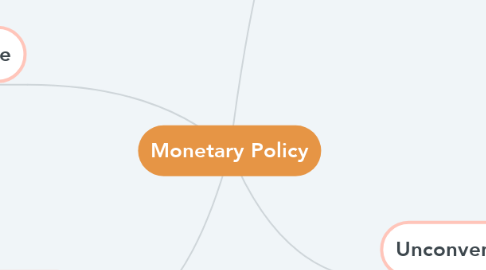
1. Interest Rate
1.1. Intervene Money Markets
1.1.1. Influence level of ST interest rates
1.1.2. Varying the rate at which central banks prepared to lend to banks
1.1.3. Malaysia: OPR
1.1.3.1. Change Base Rates
1.1.3.1.1. benchmark COF
1.2. Cost of Funding
1.2.1. KLIBOR / LIBOR: Influences interest rate benchmarks
1.2.1.1. Affects rates banks pay to both depositors
1.2.1.2. Affects rates bank charges to borrowers
1.2.1.3. Represent rate at which banks can borrow from each other in money market
1.3. Credit Level
1.3.1. Lowered Rate
1.3.1.1. reduced returns on savings product / Higher lending
1.3.2. Rising Rate
1.3.2.1. mortgage holders may find it difficult to service debt obligations
1.3.2.2. bonds and other asset classes to become less attractive and fall in value
2. Regulatory Reserve
2.1. Increase: Contractionary because reduces funds available in banking system
2.2. Decrease: Expansionary because increases funds available in banking system
3. Instruments
3.1. Repo
3.1.1. the Bank sells eligible securities, such as the Malaysian Government Securities (MGS) to banks, and at the same time and as part of the same operation, commits to repurchase the equivalent securities on a specified date at a specified price which reflects the repo rate.
3.1.1.1. used for the purpose of lending specific MGS requested by financial institutions to enhance secondary market liquidity in the bond market.
3.2. Reverse Repo
3.2.1. Reverse repo, meanwhile, is where the Bank buys eligible securities from banks, and at the same time and as part of the same operation, commits to resell the equivalent securities on a specified date at a specified price which reflects the repo rate.
3.2.1.1. to provide liquidity to the banking institutions, including lending operations under standing facilities.
3.3. Purchase Govvies
3.3.1. The Bank may purchase or sell eligible securities, namely securities issued by the Government or the Bank to adjust liquidity in the banking system.
4. Unconventional
4.1. QE
4.1.1. Central bank purchases LT govt bonds
4.1.1.1. raises price and lowering yield of these instruments, reduces longer-term interest rates
4.2. Credit Easing
4.2.1. Central bank purchases other forms of debt securities
4.2.1.1. corporate banks
4.3. Negative Rates
4.3.1. Limited by zero
4.3.2. Stimulate demand by creating a cost of holding liquidity
4.3.2.1. ECB below zero
4.3.2.1.1. Effectively charged banks to deposit their funds with central banks
4.4. Impact
4.4.1. Cost of Funding
4.4.1.1. QE: provides liquidity to banking sector
4.4.1.2. CE: Reduce interest rates of debt securities, increase bank liquidity
4.4.1.3. Negative Rates: Stimulate demand for credit
4.4.2. Credit Level
4.4.2.1. QE: Increases money supply
4.4.2.2. CE: promote greater lending, particularly to the business sector, to stimulate the economy
4.4.2.3. Negative Rates: Encourages banks to lend funds rather than hold as cash
4.4.3. QE can create Asset Bubbles
4.4.3.1. consequence of inflows of investors looking for higher returns than cash deposits
4.4.3.2. together with speculative demand attracted by rising prices
